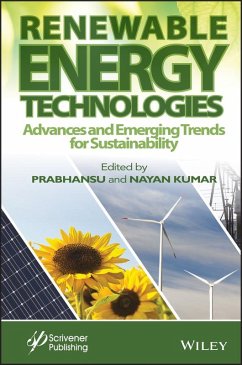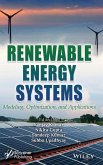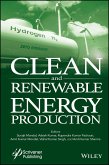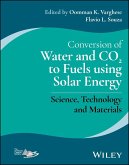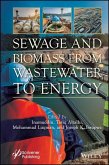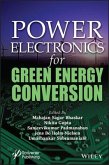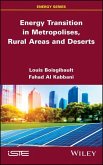Renewable Energy Technologies
Advances and Emerging Trends for Sustainability
Herausgeber: Kumar, Nayan; Prabhansu, Prabhansu
Renewable Energy Technologies
Advances and Emerging Trends for Sustainability
Herausgeber: Kumar, Nayan; Prabhansu, Prabhansu
- Gebundenes Buch
- Merkliste
- Auf die Merkliste
- Bewerten Bewerten
- Teilen
- Produkt teilen
- Produkterinnerung
- Produkterinnerung
With the goal of accelerating the growth of green energy utilization for the sustainability of life on earth, this volume, written and edited by a global team of experts, goes into the practical applications that can be utilized across multiple disciplines and industries, for both the engineer and the student. Green energy resources are gaining more attention in academia and industry as one of the preferred choices for sustainable energy conversion. Due to the energy demand, environmental impacts, economic needs, and social issues, green energy resources are being researched, developed, and…mehr
Andere Kunden interessierten sich auch für
![Renewable Energy Systems Renewable Energy Systems]() Renewable Energy Systems246,99 €
Renewable Energy Systems246,99 €![Clean and Renewable Energy Production Clean and Renewable Energy Production]() Clean and Renewable Energy Production239,99 €
Clean and Renewable Energy Production239,99 €![Conversion of Water and CO2 to Fuels Using Solar Energy Conversion of Water and CO2 to Fuels Using Solar Energy]() Conversion of Water and CO2 to Fuels Using Solar Energy200,99 €
Conversion of Water and CO2 to Fuels Using Solar Energy200,99 €![Sewage and Biomass from Wastewater to Energy Sewage and Biomass from Wastewater to Energy]() Sewage and Biomass from Wastewater to Energy211,99 €
Sewage and Biomass from Wastewater to Energy211,99 €![Power Electronics for Green Energy Conversion Power Electronics for Green Energy Conversion]() Power Electronics for Green Energy Conversion238,99 €
Power Electronics for Green Energy Conversion238,99 €![Smart Grids and Buildings for Energy and Societal Transition Smart Grids and Buildings for Energy and Societal Transition]() Benoît RobynsSmart Grids and Buildings for Energy and Societal Transition159,99 €
Benoît RobynsSmart Grids and Buildings for Energy and Societal Transition159,99 €![Energy Transition in Metropolises, Rural Areas, and Deserts Energy Transition in Metropolises, Rural Areas, and Deserts]() Louis BoisgibaultEnergy Transition in Metropolises, Rural Areas, and Deserts170,99 €
Louis BoisgibaultEnergy Transition in Metropolises, Rural Areas, and Deserts170,99 €-
-
-
With the goal of accelerating the growth of green energy utilization for the sustainability of life on earth, this volume, written and edited by a global team of experts, goes into the practical applications that can be utilized across multiple disciplines and industries, for both the engineer and the student. Green energy resources are gaining more attention in academia and industry as one of the preferred choices for sustainable energy conversion. Due to the energy demand, environmental impacts, economic needs, and social issues, green energy resources are being researched, developed, and funded more than ever before. Researchers are facing numerous challenges, but there are new opportunities waiting for green energy resource utilization within the context of environmental and economic sustainability. Efficient energy conversion from solar, wind, biomass, fuel cells, and others are paramount to this overall mission and the success of these efforts. Written and edited by a global team of experts, this groundbreaking new volume from Scrivener Publishing presents recent advances in the study of green energy across a variety of fields and sources. Various applications of green energy resources, modeling and performance analysis, and grid integration aspects of green energy resources are considered. Not only laying out the concepts in an easy-to-understand way, but this team offers the engineer, scientist, student, or other professional practical solutions to everyday problems in their daily applications. Valuable as a learning tool for beginners in this area as well as a daily reference for engineers and scientists working in these areas, this is a must-have for any library.
Hinweis: Dieser Artikel kann nur an eine deutsche Lieferadresse ausgeliefert werden.
Hinweis: Dieser Artikel kann nur an eine deutsche Lieferadresse ausgeliefert werden.
Produktdetails
- Produktdetails
- Verlag: Wiley
- Seitenzahl: 672
- Erscheinungstermin: 27. September 2022
- Englisch
- Abmessung: 231mm x 152mm x 38mm
- Gewicht: 1021g
- ISBN-13: 9781119827504
- ISBN-10: 1119827507
- Artikelnr.: 61329832
- Herstellerkennzeichnung
- Libri GmbH
- Europaallee 1
- 36244 Bad Hersfeld
- gpsr@libri.de
- Verlag: Wiley
- Seitenzahl: 672
- Erscheinungstermin: 27. September 2022
- Englisch
- Abmessung: 231mm x 152mm x 38mm
- Gewicht: 1021g
- ISBN-13: 9781119827504
- ISBN-10: 1119827507
- Artikelnr.: 61329832
- Herstellerkennzeichnung
- Libri GmbH
- Europaallee 1
- 36244 Bad Hersfeld
- gpsr@libri.de
Prabhansu, PhD, is an assistant professor in the Department of Mechanical Engineering at Sardar Vallabhbhai National Institute of Technology Surat, Gujarat, India. He is associated with the Renewable and Sustainable Energy Lab at the Institute and has been working in the field of solar energy extraction and gasification for the past 11 years. Nayan Kumar, PhD, is an assistant professor in the Department of Electrical Engineering, Muzaffarpur Institute of Technology, Muzaffarpur, Bihar, India. He earned his PhD in electrical engineering from the National Institute of Technology Durgapur, India, and he is an editor on a number of books with Scrivener Publishing.
Preface 1. Comparison of Drag Models for Hydrodynamic Flow Behavior Analysis of Bubbling Fluidized Bed Sourav Ganguli, Prabhansu and Malay Kr. Karmakar 1.1 Introduction 1.2 Mathematical Model 1.3 Results and Discussion 1.4 Conclusion 18 References 2. Pathways of Renewable Energy Sources in Rajasthan for Sustainable Growth Hemani Paliwal, Vikramaditya Dave and Sujeet Kumar 2.1 Introduction 2.2 Renewable Energy in India 2.3 Renewable Energy in Rajasthan 2.4 Government Initiatives 2.5 Major Achievements 2.6 Environment Effects 2.7 Conclusion 3. Distributed Generation Policy in India: Challenges and Opportunities J. N. Roy, Uday Shankar and Ajaykumar Chaurasiya 3.1 Background 3.2 Electricity Access in India 3.3 DG System Position in Existing Legal and Policy Framework of India 3.4 Analysis and Challenges in the DG System 3.5 Conclusion 4. Sustainable Development of Nanomaterials for Energy and Environmental Protection Applications Mohamed Jaffer Sadiq Mohamed 4.1 Introduction 4.2 Photocatalysis 4.3 Electrocatalysis 4.4 Supercapacitors 4.5 Conclusions 5. Semiconductor Quantum Dot Solar Cells: Construction, Working Principle, and Current Development Hirendra Das and Pranayee Datta 5.1 Introduction 5.2 Solar Cell Operation (Photovoltaic Effect) 5.3 Quantum Dot Based Solar Cells 5.4 Materials for QDSSCs 5.5 Conclusion and Future Prospects 6. Review on Productivity Enhancement of Passive Solar Stills Subbarama Kousik Suraparaju and Sendhil Kumar Natarajan 6.1 Introduction 6.2 Need for Desalination in India & Other Parts of World 6.3 Significance of Solar Energy -- Indian Scenario 6.4 Desalination Process Powered by Solar Energy 6.5 Solar Still 6.6 Methods to Augment the Potable Water Yield in Passive Solar Still 6.7 Factors Affecting the Rate of Productivity 6.8 Corollary on Productivity Enhancement Methods 6.9 Conclusions and Future Recommendations 7. Subsynchronous Resonance Issues in Integrating Large Windfarms to Grid R. Mahalakshmi and K.C. Sindhu Thampatty 7.1 Introduction 7.2 Literature Survey 7.3 DFIG Based Grid Integrated WECs 7.4 Modeling of System Components 7.5 Analysis of Subsynchronous Resonance 7.6 Hardware Implementation 7.7 Conclusion 8. Emerging Trends for Biomass and Waste to Energy Conversion Musademba Downmore, Chihobo Chido H. and Garahwa Zvikomborero 8.1 Introduction 8.2 Hydrothermal Processing 8.3 Opportunities and Challenges in Hydrothermal Processing (HTP) 8.4 Bio-Methanation Process 8.5 Integrating AD-HTP 8.6 Waste to Energy Conversion 8.7 Impacts of COVID-19 on Biomass and Waste to Energy Conversion 8.8 Conclusion 9. Renewable Energy Policies and Standards for Energy Storage and Electric Vehicles in India Prateek Srivastava, Shashank Vyas and Nilesh B. Hadiya 9.1 Introduction 9.2 Structure of the Indian Power System 9.3 Status of RE in India 9.4 Legal Aspects of Electricity and Consumer Rights in India 9.5 Policies, Programs, and Standards Related to Energy Storage and EVs 9.6 Electricity Market-Related Developments for Accommodating More RE 9.7 Conclusion 10. Durable Catalyst Support for PEFC Application P. Dhanasekaran, S. Vinod Selvaganesh and Santoshkumar D. Bhat 10.1 Introduction 10.2 Classification of Fuel Cells and Operating Principle 10.3 Direct Methanol Fuel Cells (DMFC) 10.4 Fuel Cell Performance and Stability 10.5 Effect of TiO2 Based Catalysts/Supports for H2-PEFC and DMFC 10.6 Variable Phase of TiO2 Supported Pt Towards Fuel Cell Application 10.7 Influence of Doping in TiO2 Towards ORR 10.8 Influence of Morphology Towards Oxygen Reduction Reaction 10.9 Effect of Titania-Carbon Composite Supported Pt Electrocatalyst for PEFC 10.10 PEFC Stack Operation and Durability Studies with Alternate Catalyst Support 10.11 Summary and Way Forward 11. Unitized Regenerative Fuel Cells: Future of Renewable Energy Research Devi Renuka K., Santoshkumar D. Bhat and Sreekuttan M. Unni 11.1 Introduction 11.2 Principle of URFC 11.3 Classification of URFCs 11.4 Case Studies on URFCs 11.5 Conclusion 12. Energy Storage for Distributed Energy Resources Udaya Bhasker Manthati, Srinivas Punna and Arunkumar C. R. 12.1 Introduction 12.2 Types of Energy Storage Systems 12.3 Power Electronic Interface 12.4 Control of Different HESS Configurations 12.5 Battery Modeling Techniques 12.6 Applications 12.7 Challenges and Future of ESSs 12.8 Conclusions 13. Comprehensive Analysis on DC-Microgrid Application for Remote Electrification Yugal Kishor, C.H. Kamesh Rao and R.N. Patel 13.1 Introduction 13.2 Background of DC-muG 13.3 DC-
G Architectures 13.4 DC-
G Voltage Polarity 13.5 Single Bus DC-
G 13.6 Radial Architecture of DC-
G 13.7 Ladder Type DC-
G 13.8 Topological Overview of DC-DC Converters 13.9 DC-
G Control Schemes 13.10 Key Challenges and Direction of Future Research 13.11 Conclusions 14. Thermo-Hydraulic Performance of Solar Air Heater Tabish Alam and Karmveer 14.1 Introduction 14.2 Solar Air Heater (SAH) 14.3 Performance Evaluation of a SAH 14.4 Collector Performance Testing and Prediction 14.5 Performance Enhancement Methods of Solar Air Collector 14.6 Thermo-Hydraulic Performance 14.7 Prediction of Net Effective Efficiency of Conical Protrusion Ribs on Absorber of SAH: A Case Study 14.8 Conclusions 15. Artificial Intelligent Approaches for Load Frequency Control in Isolated Microgrid with Renewable Energy Sources S. Anbarasi, K. Punitha, S. Krishnaveni and R. Aruna 15.1 Introduction 15.2 Microgrid Integrated with Renewable Energy Resources 15.3 Control Strategy for LFC in Micro Grid 15.4 Simulation Results and Discussions: Case Study 15.5 Summary and Future Scope 16. Analysis of Brushless Doubly Fed Induction Machine Resmi R. 16.1 Introduction 16.2 A Study on BDFIM 16.3 FEM Analysis of BDFIM Performance 16.4 Fabrication of BDFIM 16.5 Testing of Prototype BDFIM as Motor 16.6 Testing of BDFIM as a Generator 16.7 Conclusion 17. SMC Augmented Droop Control Scheme for Improved Small Signal Stability of Inverter Dominated Microgrid Binu Krishnan U. and Mija S. J. 17.1 Introduction 17.2 Small Signal Model of Droop Controlled MG System 17.3 Droop Controller with SMC 17.4 Conclusion 18. Energy Scenarios Due to Southern Pine Beetle Outbreak in Honduras Juan F. Reyez-Meza, Juan G. Elvir-Hernandez, Wilfredo C. Flores, Harold R. Chamorro, Jacobo Aguillon-Garcia, Vijay K. Sood, Kyri Baker, Ameena Al-Sumaiti, Francisco Gonzalez-Longatt and Wilmar Martinez 18.1 Introduction 18.2 SPB (Southern Pine Beetle) 18.3 Implementation of Methodology 18.4 Scenario Taking Into Consideration the Energy Demand Conclusions References Appendix Index
G Architectures 13.4 DC-
G Voltage Polarity 13.5 Single Bus DC-
G 13.6 Radial Architecture of DC-
G 13.7 Ladder Type DC-
G 13.8 Topological Overview of DC-DC Converters 13.9 DC-
G Control Schemes 13.10 Key Challenges and Direction of Future Research 13.11 Conclusions 14. Thermo-Hydraulic Performance of Solar Air Heater Tabish Alam and Karmveer 14.1 Introduction 14.2 Solar Air Heater (SAH) 14.3 Performance Evaluation of a SAH 14.4 Collector Performance Testing and Prediction 14.5 Performance Enhancement Methods of Solar Air Collector 14.6 Thermo-Hydraulic Performance 14.7 Prediction of Net Effective Efficiency of Conical Protrusion Ribs on Absorber of SAH: A Case Study 14.8 Conclusions 15. Artificial Intelligent Approaches for Load Frequency Control in Isolated Microgrid with Renewable Energy Sources S. Anbarasi, K. Punitha, S. Krishnaveni and R. Aruna 15.1 Introduction 15.2 Microgrid Integrated with Renewable Energy Resources 15.3 Control Strategy for LFC in Micro Grid 15.4 Simulation Results and Discussions: Case Study 15.5 Summary and Future Scope 16. Analysis of Brushless Doubly Fed Induction Machine Resmi R. 16.1 Introduction 16.2 A Study on BDFIM 16.3 FEM Analysis of BDFIM Performance 16.4 Fabrication of BDFIM 16.5 Testing of Prototype BDFIM as Motor 16.6 Testing of BDFIM as a Generator 16.7 Conclusion 17. SMC Augmented Droop Control Scheme for Improved Small Signal Stability of Inverter Dominated Microgrid Binu Krishnan U. and Mija S. J. 17.1 Introduction 17.2 Small Signal Model of Droop Controlled MG System 17.3 Droop Controller with SMC 17.4 Conclusion 18. Energy Scenarios Due to Southern Pine Beetle Outbreak in Honduras Juan F. Reyez-Meza, Juan G. Elvir-Hernandez, Wilfredo C. Flores, Harold R. Chamorro, Jacobo Aguillon-Garcia, Vijay K. Sood, Kyri Baker, Ameena Al-Sumaiti, Francisco Gonzalez-Longatt and Wilmar Martinez 18.1 Introduction 18.2 SPB (Southern Pine Beetle) 18.3 Implementation of Methodology 18.4 Scenario Taking Into Consideration the Energy Demand Conclusions References Appendix Index
Preface 1. Comparison of Drag Models for Hydrodynamic Flow Behavior Analysis of Bubbling Fluidized Bed Sourav Ganguli, Prabhansu and Malay Kr. Karmakar 1.1 Introduction 1.2 Mathematical Model 1.3 Results and Discussion 1.4 Conclusion 18 References 2. Pathways of Renewable Energy Sources in Rajasthan for Sustainable Growth Hemani Paliwal, Vikramaditya Dave and Sujeet Kumar 2.1 Introduction 2.2 Renewable Energy in India 2.3 Renewable Energy in Rajasthan 2.4 Government Initiatives 2.5 Major Achievements 2.6 Environment Effects 2.7 Conclusion 3. Distributed Generation Policy in India: Challenges and Opportunities J. N. Roy, Uday Shankar and Ajaykumar Chaurasiya 3.1 Background 3.2 Electricity Access in India 3.3 DG System Position in Existing Legal and Policy Framework of India 3.4 Analysis and Challenges in the DG System 3.5 Conclusion 4. Sustainable Development of Nanomaterials for Energy and Environmental Protection Applications Mohamed Jaffer Sadiq Mohamed 4.1 Introduction 4.2 Photocatalysis 4.3 Electrocatalysis 4.4 Supercapacitors 4.5 Conclusions 5. Semiconductor Quantum Dot Solar Cells: Construction, Working Principle, and Current Development Hirendra Das and Pranayee Datta 5.1 Introduction 5.2 Solar Cell Operation (Photovoltaic Effect) 5.3 Quantum Dot Based Solar Cells 5.4 Materials for QDSSCs 5.5 Conclusion and Future Prospects 6. Review on Productivity Enhancement of Passive Solar Stills Subbarama Kousik Suraparaju and Sendhil Kumar Natarajan 6.1 Introduction 6.2 Need for Desalination in India & Other Parts of World 6.3 Significance of Solar Energy -- Indian Scenario 6.4 Desalination Process Powered by Solar Energy 6.5 Solar Still 6.6 Methods to Augment the Potable Water Yield in Passive Solar Still 6.7 Factors Affecting the Rate of Productivity 6.8 Corollary on Productivity Enhancement Methods 6.9 Conclusions and Future Recommendations 7. Subsynchronous Resonance Issues in Integrating Large Windfarms to Grid R. Mahalakshmi and K.C. Sindhu Thampatty 7.1 Introduction 7.2 Literature Survey 7.3 DFIG Based Grid Integrated WECs 7.4 Modeling of System Components 7.5 Analysis of Subsynchronous Resonance 7.6 Hardware Implementation 7.7 Conclusion 8. Emerging Trends for Biomass and Waste to Energy Conversion Musademba Downmore, Chihobo Chido H. and Garahwa Zvikomborero 8.1 Introduction 8.2 Hydrothermal Processing 8.3 Opportunities and Challenges in Hydrothermal Processing (HTP) 8.4 Bio-Methanation Process 8.5 Integrating AD-HTP 8.6 Waste to Energy Conversion 8.7 Impacts of COVID-19 on Biomass and Waste to Energy Conversion 8.8 Conclusion 9. Renewable Energy Policies and Standards for Energy Storage and Electric Vehicles in India Prateek Srivastava, Shashank Vyas and Nilesh B. Hadiya 9.1 Introduction 9.2 Structure of the Indian Power System 9.3 Status of RE in India 9.4 Legal Aspects of Electricity and Consumer Rights in India 9.5 Policies, Programs, and Standards Related to Energy Storage and EVs 9.6 Electricity Market-Related Developments for Accommodating More RE 9.7 Conclusion 10. Durable Catalyst Support for PEFC Application P. Dhanasekaran, S. Vinod Selvaganesh and Santoshkumar D. Bhat 10.1 Introduction 10.2 Classification of Fuel Cells and Operating Principle 10.3 Direct Methanol Fuel Cells (DMFC) 10.4 Fuel Cell Performance and Stability 10.5 Effect of TiO2 Based Catalysts/Supports for H2-PEFC and DMFC 10.6 Variable Phase of TiO2 Supported Pt Towards Fuel Cell Application 10.7 Influence of Doping in TiO2 Towards ORR 10.8 Influence of Morphology Towards Oxygen Reduction Reaction 10.9 Effect of Titania-Carbon Composite Supported Pt Electrocatalyst for PEFC 10.10 PEFC Stack Operation and Durability Studies with Alternate Catalyst Support 10.11 Summary and Way Forward 11. Unitized Regenerative Fuel Cells: Future of Renewable Energy Research Devi Renuka K., Santoshkumar D. Bhat and Sreekuttan M. Unni 11.1 Introduction 11.2 Principle of URFC 11.3 Classification of URFCs 11.4 Case Studies on URFCs 11.5 Conclusion 12. Energy Storage for Distributed Energy Resources Udaya Bhasker Manthati, Srinivas Punna and Arunkumar C. R. 12.1 Introduction 12.2 Types of Energy Storage Systems 12.3 Power Electronic Interface 12.4 Control of Different HESS Configurations 12.5 Battery Modeling Techniques 12.6 Applications 12.7 Challenges and Future of ESSs 12.8 Conclusions 13. Comprehensive Analysis on DC-Microgrid Application for Remote Electrification Yugal Kishor, C.H. Kamesh Rao and R.N. Patel 13.1 Introduction 13.2 Background of DC-muG 13.3 DC-
G Architectures 13.4 DC-
G Voltage Polarity 13.5 Single Bus DC-
G 13.6 Radial Architecture of DC-
G 13.7 Ladder Type DC-
G 13.8 Topological Overview of DC-DC Converters 13.9 DC-
G Control Schemes 13.10 Key Challenges and Direction of Future Research 13.11 Conclusions 14. Thermo-Hydraulic Performance of Solar Air Heater Tabish Alam and Karmveer 14.1 Introduction 14.2 Solar Air Heater (SAH) 14.3 Performance Evaluation of a SAH 14.4 Collector Performance Testing and Prediction 14.5 Performance Enhancement Methods of Solar Air Collector 14.6 Thermo-Hydraulic Performance 14.7 Prediction of Net Effective Efficiency of Conical Protrusion Ribs on Absorber of SAH: A Case Study 14.8 Conclusions 15. Artificial Intelligent Approaches for Load Frequency Control in Isolated Microgrid with Renewable Energy Sources S. Anbarasi, K. Punitha, S. Krishnaveni and R. Aruna 15.1 Introduction 15.2 Microgrid Integrated with Renewable Energy Resources 15.3 Control Strategy for LFC in Micro Grid 15.4 Simulation Results and Discussions: Case Study 15.5 Summary and Future Scope 16. Analysis of Brushless Doubly Fed Induction Machine Resmi R. 16.1 Introduction 16.2 A Study on BDFIM 16.3 FEM Analysis of BDFIM Performance 16.4 Fabrication of BDFIM 16.5 Testing of Prototype BDFIM as Motor 16.6 Testing of BDFIM as a Generator 16.7 Conclusion 17. SMC Augmented Droop Control Scheme for Improved Small Signal Stability of Inverter Dominated Microgrid Binu Krishnan U. and Mija S. J. 17.1 Introduction 17.2 Small Signal Model of Droop Controlled MG System 17.3 Droop Controller with SMC 17.4 Conclusion 18. Energy Scenarios Due to Southern Pine Beetle Outbreak in Honduras Juan F. Reyez-Meza, Juan G. Elvir-Hernandez, Wilfredo C. Flores, Harold R. Chamorro, Jacobo Aguillon-Garcia, Vijay K. Sood, Kyri Baker, Ameena Al-Sumaiti, Francisco Gonzalez-Longatt and Wilmar Martinez 18.1 Introduction 18.2 SPB (Southern Pine Beetle) 18.3 Implementation of Methodology 18.4 Scenario Taking Into Consideration the Energy Demand Conclusions References Appendix Index
G Architectures 13.4 DC-
G Voltage Polarity 13.5 Single Bus DC-
G 13.6 Radial Architecture of DC-
G 13.7 Ladder Type DC-
G 13.8 Topological Overview of DC-DC Converters 13.9 DC-
G Control Schemes 13.10 Key Challenges and Direction of Future Research 13.11 Conclusions 14. Thermo-Hydraulic Performance of Solar Air Heater Tabish Alam and Karmveer 14.1 Introduction 14.2 Solar Air Heater (SAH) 14.3 Performance Evaluation of a SAH 14.4 Collector Performance Testing and Prediction 14.5 Performance Enhancement Methods of Solar Air Collector 14.6 Thermo-Hydraulic Performance 14.7 Prediction of Net Effective Efficiency of Conical Protrusion Ribs on Absorber of SAH: A Case Study 14.8 Conclusions 15. Artificial Intelligent Approaches for Load Frequency Control in Isolated Microgrid with Renewable Energy Sources S. Anbarasi, K. Punitha, S. Krishnaveni and R. Aruna 15.1 Introduction 15.2 Microgrid Integrated with Renewable Energy Resources 15.3 Control Strategy for LFC in Micro Grid 15.4 Simulation Results and Discussions: Case Study 15.5 Summary and Future Scope 16. Analysis of Brushless Doubly Fed Induction Machine Resmi R. 16.1 Introduction 16.2 A Study on BDFIM 16.3 FEM Analysis of BDFIM Performance 16.4 Fabrication of BDFIM 16.5 Testing of Prototype BDFIM as Motor 16.6 Testing of BDFIM as a Generator 16.7 Conclusion 17. SMC Augmented Droop Control Scheme for Improved Small Signal Stability of Inverter Dominated Microgrid Binu Krishnan U. and Mija S. J. 17.1 Introduction 17.2 Small Signal Model of Droop Controlled MG System 17.3 Droop Controller with SMC 17.4 Conclusion 18. Energy Scenarios Due to Southern Pine Beetle Outbreak in Honduras Juan F. Reyez-Meza, Juan G. Elvir-Hernandez, Wilfredo C. Flores, Harold R. Chamorro, Jacobo Aguillon-Garcia, Vijay K. Sood, Kyri Baker, Ameena Al-Sumaiti, Francisco Gonzalez-Longatt and Wilmar Martinez 18.1 Introduction 18.2 SPB (Southern Pine Beetle) 18.3 Implementation of Methodology 18.4 Scenario Taking Into Consideration the Energy Demand Conclusions References Appendix Index

